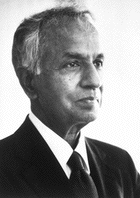
Back سابرامانين تشاندراسخار Arabic سابرامانين تشاندراسخار ARZ সুব্ৰহ্মণ্যন চন্দ্ৰশেখৰ Assamese Subrahmanyan Chandrasekhar AST سابراهمانین چاندراسکار AZB Субраманьян Чандрасекар Bashkir Субрахманьян Чандрасекар Byelorussian Субраманиан Чандрасекар Bulgarian সুব্রহ্মণ্যন চন্দ্রশেখর Bengali/Bangla Subrahmanyan Chandrasekhar Catalan
Subrahmanyan Chandrasekhar FRS (/ˌtʃændrəˈʃeɪkər/;[3] 19 October 1910 – 21 August 1995)[4] was an Indian American theoretical physicist who made significant contributions to understanding of stellar evolution, black holes, and the structure of stars. He was awarded the 1983 Nobel Prize in physics along with William A. Fowler for "...theoretical studies of the physical processes of importance to the structure and evolution of the stars". His mathematical treatment of stellar evolution yielded many of the current theoretical models of the later evolutionary stages of massive stars and black holes.[5][6] Many concepts, institutions, and inventions, including the Chandrasekhar limit and the Chandra X-Ray Observatory, are named after him.[7]
Chandrasekhar worked on a wide variety of problems in physics during his lifetime, contributing to the contemporary understanding of stellar structure, white dwarfs, stellar dynamics, stochastic process, radiative transfer, the quantum theory of the hydrogen anion, hydrodynamic and hydromagnetic stability, turbulence, equilibrium and the stability of ellipsoidal figures of equilibrium, general relativity, mathematical theory of black holes and theory of colliding gravitational waves.[8] At the University of Cambridge, he developed a theoretical model explaining the structure of white dwarf stars that took into account the relativistic variation of mass with the velocities of electrons that comprise their degenerate matter. He showed that the mass of a white dwarf could not exceed 1.44 times that of the Sun – the Chandrasekhar limit. Chandrasekhar revised the models of stellar dynamics first outlined by Jan Oort and others by considering the effects of fluctuating gravitational fields within the Milky Way on stars rotating about the galactic centre. His solution to this complex dynamical problem involved a set of twenty partial differential equations, describing a new quantity he termed "dynamical friction", which has the dual effects of decelerating the star and helping to stabilize clusters of stars. Chandrasekhar extended this analysis to the interstellar medium, showing that clouds of galactic gas and dust are distributed very unevenly.
Chandrasekhar studied at Presidency College, Madras (now Chennai) and the University of Cambridge. A long-time professor at the University of Chicago, he did some of his studies at the Yerkes Observatory, and served as editor of The Astrophysical Journal from 1952 to 1971. He was on the faculty at Chicago from 1937 until his death in 1995 at the age of 84, and was the Morton D. Hull Distinguished Service Professor of Theoretical Astrophysics.[9]
- ^ Cite error: The named reference
Tayler1996was invoked but never defined (see the help page). - ^ "Subrahmanyan Chandrasekhar – The Mathematics Genealogy Project". www.genealogy.math.ndsu.nodak.edu.
- ^ "Great Indians: Professor Subrahmanyan Chandrasekhar" – via NDTV.
- ^ Osterbrock, Donald E. (December 1998). "Subrahmanyan Chandrasekhar (19 October 1910 – 21 August 1995)". Proceedings of the American Philosophical Society. 142 (4). American Philosophical Society: 658–665. ISSN 0003-049X. JSTOR 3152289. (Registration or subscription required)
- ^ Vishveshwara, C.V. (25 April 2000). "Leaves from an unwritten diary: S. Chandrasekhar, Reminiscences and Reflections" (PDF). Current Science. 78 (8): 1025–1033.
- ^ Horgan, J. (1994). "Profile: Subrahmanyan Chandrasekhar – Confronting the Final Limit". Scientific American. 270 (3): 32–33. doi:10.1038/scientificamerican0394-32. ISSN 0036-8733.
- ^ Sreenivasan, K. R. (2019). "Chandrasekhar's Fluid Dynamics". Annual Review of Fluid Mechanics. 51 (1): 1–24. Bibcode:2019AnRFM..51....1S. doi:10.1146/annurev-fluid-010518-040537. ISSN 0066-4189.
- ^ Cite error: The named reference
standrewswas invoked but never defined (see the help page). - ^ "Subrahmanyan Chandrasekhar". starchild.gsfc.nasa.gov. Retrieved 19 October 2017.
© MMXXIII Rich X Search. We shall prevail. All rights reserved. Rich X Search
